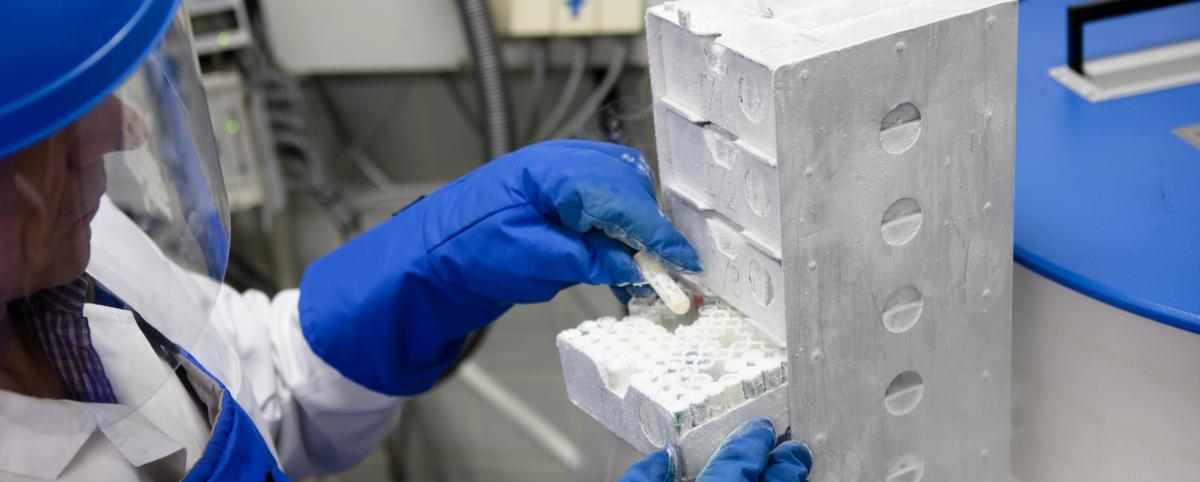Specimen Procurement & Repository

Access biological samples and tissue for your University of Minnesota research.
Request samples
Off-campus requests require a VPN connection
Specimens available now via our biobank — tissues, FFPE, and biofluids
…and much more.
Specimens by storage method
Frozen tissue
Frozen tissue
More than 38,000 frozen tissues (cryovials, OCT, foil) stored in liquid nitrogen or at -80 degrees Celsius.
- Abdominal wall
- Bladder
- Brain
- Breast
- Cervix
- Colon
- Endometrium
- Fallopian tube
- Gallbladder
- Heart
- Kidney
- Liver
- Lung
- Lymph node
- Omentum
- Ovary
- Pancreas
- Prostate
- Skin
- Small intestine
- Spleen
- Thymus
- Thyroid gland
- Tongue
- Uterus
Formalin-fixed, paraffin-embedded (FFPE)
Formalin-fixed, paraffin-embedded (FFPE)
More than 23,000 FFPE stored at room temperature, with H&E slides for quality control.
- Bladder
- Bone
- Breast
- Cervix
- Colon
- Endometrium
- Kidney
- Liver
- Lung
- Lymph node
- Muscle
- Omentum
- Ovary
- Pancreas
- Prostate
- Skin
- Small intestine
- Stomach
- Thymus
- Tonsils
- Uterus
- …and more
Biofluids
More than 10,000 biofluids stored at 80 degrees Celsius.
- Serum
- Plasma
- Whole blood
- Urine
- Buffy coat
- Ascites
Need something else? Contact us
How to request specimen from our biorepository
Step 1: Request our services via the CTR Portal
Step 1: Request our services via the CTR Portal
Off-campus use requires a VPN connection
Step 2: Request specific samples
Step 2: Request specific samples
Tell us what you're looking for so we can start searching for eligible samples.
Step 3: Cases identified by our team
Step 3: Cases identified by our team
We'll identify cases using data captured by our team
- Specimen (tissue) type.
- Tissue status (MAL, MET, etc.).
- Specimen format.
- Sample age.
- Sample matching (FFPE + frozen pair, MAL + NAT from same subject, tissue + blood).
Step 4: Chart review
Step 4: Chart review
Chart reviews are done manually by our team or in collaboration with CTSI’s informatics team (BPIC).
- Final pathology diagnosis.
- Treated/untreated.
- Therapeutics (specific or general class).
- Receptor or mutation status.
- Clinical diagnosis.
- Recurrence/refractory.
Step 5: Preliminary results shared
Step 5: Preliminary results shared
- Investigators receive a spreadsheet of preliminary results (list of all possible cases that meet study criteria).
- "Preliminary" indicates samples must go through quality control (QC) to confirm status and quality.
- Investigator chooses which samples go through QC.
Step 6: Pathologist QC
Step 6: Pathologist QC
- Tissue status (diseased, normal, malignant, normal adjacent, or benign).
- QC diagnosis/comments (at discretion of pathologist, additional details that may be helpful to determine if/how sample should be used for research).
- Viable neoplasia percent.
Step 7: Final results shared
- Investigator reviews QC results and chooses samples for distribution.
- We provide a limited dataset that goes back one year prior to surgery and includes:
- Basic demographics
- Pathology reports
- Medication list
- Social history
- Medical history
- Treatment history
- Lab tests
- Surgical procedure
- Sample info
Biobank details
How we collect archived samples
How we collect archived samples
We adhere to best practices every step of the way.
Screening and consent
- Review surgical schedule for procedures that would yield excess clinical tissue.
- Screening process based on current research needs from investigator protocols and fresh tissue procurement requests.
- Informed consent for excess tissue, optional biofluids, and optional sensitive health information.
Procurement
- Tissue chain of custody: surgical tissue is released to Pathology for patient clinical care, tissue deemed excess by Pathology is released to us.
- Tissue is processed and samples are de-identified.
- Honest broker: We act on behalf of researchers to collect and distribute de-identified specimens.
- Investigator protocols and fresh tissue needs are prioritized.
Biobanking
- Only tissue in excess of investigator and fresh needs are collected for our repository.
- Sample, patient, and some clinical data are maintained in BSI (specimen tracking software).
- Honest broker: We maintain the key to patient identity in order to link samples back to the EHR.
- Review and approve sample requests for retrospective studies.
- Perform chart review to determine eligible samples.
Custodial storage
Custodial storage
In limited circumstances, we can accommodate some short-term custodial storage. Please contact us at [email protected] to discuss your needs.
Archival diagnostic tissue
Archival diagnostic tissue
For information about accessing archival diagnostic FFPE material, contact:
Anatomic Pathology Research Coordinator
[email protected]